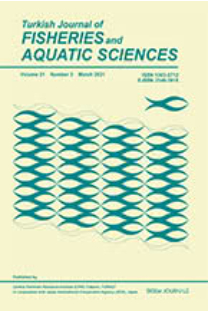The catch composition and catch per unit of swept area (CPUE) of penaeid shrimps in the bottom trawls from iskenderun by, Turkey
The objectives of present study were (i) to identify catch composition, (ii) to determine the CPUE, and (Hi) to determine the percentage of penaeid shrimps in the total economic catch. Surveys were conducted between March 2002 and February 2003 in İskenderun Bay (NE Mediterranean Sea). The sampling area was divided into two strata by depth and then the stratified random sampling technique was applied to collect data. During the study, Penaeus semisulcatus (de-Hann, 1844), Marsupenaeus (Penaeus) japonicus (Bate, 1888), Merlicertus (Penaeus) kerathurus (Forskal, 1775), Metapenaeus stebbingi (Nobii, 1904), and Metapenaeus monoceros (Fabricus, 1798) were observed in the catch composition. Among these species, M. stebbingi had the highest average catch rate (76.9%) among all total shrimp. A similar trend was observed in the total economic catch (5.1%). The mean catch per unit effort (CPUE ± SD) of the M. stebbingi (73.43±76.9 kg/km2) was significantly higher than those of the other species. M. stebbingi was caught in both strata, while CPUE was the same in both stratum I and stratum II. However, the variability in stratum I was higher than in stratum II. Hyperstability or density-dependent catchability was not observed in either of the strata for any of the species (P > 0.05).
___
Abdel Razek, F.A. 1985. Contribution to the Biology of Penaeid Prawns of the Mediterranean Coast of Egypt. I. Maturation and Spawning. J. Egypt. Vet. Med. Ass., 45 (2): 17-28.Abdul Ghaffar, A.R. 1995. Review of Kuwait's Shrimp Fisheries, Their Development and Present Status. The Technical Consultation on Shrimp Management in the Arabian Gullf, Kuwait: 1-26.
Anonymous 2003. Crustacean Fisheries. Fish.Res., 65:1-2.
Baily-Brock, J.H. and Moss, S.M. 1992. Perİİid Taxonomy Biology and Zoogeography. A.W., Fast and L.J., Lester (Eds.), Marine Shrimp Culture Principles and Practices, Elsevier, Amsterdam-London-New York-Tokyo: 9-27.
Bayhan, K. 1984. A Report on the Potential of Shrimp Stocks and Determination of Reproduction Time in the Bay of Mersin. Ministry of Agriculture and Rural Affairs Department of Fisheries, Mersin.
Bingel, F. 2002. Balık Popülasyonlannın İncelenmesi. Baki Kitabevi, Adana, 404 pp.
Bishara, F.N. 1976. Contributions to the Biology of Penaeid Prawns in Lake Manzalah. Egypt. Growth Studies and Length Weight Relationship. Aquaculture, 8: 337-339.
Can, M.F. and Şereflişan, H. 2000. İskenderun Körfezi Dörtyol Civarında Yaşayan Penaeus semisulcatus (de Haan, 1844) Karides Türünün Bazı Populasyon Özellikleri, Doğu Anadolu Bölgesi IV. Su Ürünleri Sempozyumu, 28-30 Haziran 2000, Erzurum.
Colloca, F., Cardinale, M., Belluscio, A. and Ardizzone, G. 2003. Pattern of Distribution of Demersal Assemblages in the Central Mediterranean Sea. Estuar. Coas. Shelf S., 56: 469-480.
Ghobashy, A.F.A., Mohammed, S.Z., Gap-Alla, A.A-F.A. and Hartnoil, R.G. 1991. On the Crustacean Fisheries of the Suez Canal. J. Egypt.Ger.Soc.ZooL, (4): 301 312.
Ishak, M.M., Alsayed, A.A. and Abdel Razek, B.A. 1980. Bionomies of Penaeus kerathurus Transplanted into Lake Quatum (Egypt). Aquaculture, 21: 365-374.
JICA (Japan International Cooperation Agency). 1993. Survey Report of Demersal Fishery Resources in Marmara, Aegean and Mediterranean. TKB Tarımsal Üretim ve Geliştirme Müdürlüğü, Ankara.
Kedidi, S.M. 1995. Review of the Saudi Arabian Gulf Shrimp Fishery with a Summarized Assessment of the 1991 Gulf War Effects. The Technical Consultation on Shrimp Management in the Arabian Gullf, Kuwait: 1-9.
Kocataş, A. and Katağan, T. 2003. The Decapod Crustacean Fauna of the Turkish Seas. Zoology in the Middle East, 29: 63-74.
Kocataş, A., Katagan, T., Ucal, O. and Benli, H.A. 1991. Shrimps of Turkey and Shrimp Culture. Ministry of Agriculture and Rural Affairs, Institute of Fisheries, Bodrum.
Kumlu, M. 2001. Karides, İstakoz ve Midye Yetiştiriciliği. Çukurova Üniversitesi, Su Ürünleri Fakültesi Yayınları, No: 6, Adana, 305 pp.
Kumlu, M., Başusta, N., Avşar, D. and Eroldoğan, O.T. 1999. Some Biological Aspects of Penaeips Shrimps in Yumurtalık Bight of North-eastern Mediterranean. Turk. J. Zool, 23: 215-229.
Kumlu, M., Eroldoğan, O.T., Aktaş, M. and Göçer, M. 2002. A new Shrimp Record for-the Turkish seas: Melicertus hathor (Burkenroad, 1959) (Penaeidae: Crustacea). Isr. J. Zool, 48: 246-247.
Maunder, M.N. 2001. A General Framework for Integrating the Standardization of Catch Per unit of Effort into Stock Assessment Models. Can. J. Fish. Aquat. Sci., 58: 765-803.
Salthaug, A. and Aanes, S. 2003. Catchability and the Spatial Distribution of Fishing Vessels. Can. J. Fish. Aquat. Sci., 60(3): 259-268.
Sbrana, M., Sardor, P. and Belcari, P. 2003. Analysis of the Factors Effecting Crustacean Fishery Catch Rates in the Northern Tyrrhenian Sea (Western Mediterranean). Fish. Res., 65: 271-284.
Shelton, J.H., Myers, R.A. and Dunn, A. 2001. Is Catch Per-Unit-Effort Proportional to Abundance? Can. J. Fish. Aquat. Sci., 58(9): 1760-1772.
Smith, M.T. and Addison, J.T. 2003. Methods for Stock Assessment of Crustacean Fisheries. Fish. Res., 65: 231-256.
Somerton, D.A., Otto, R.S. and Syrjala, S.E. 2002. Can Changes in Tow Duration on Bottom Trawl Surveys Lead to Changes in CPUE and Mean Size? Fish. Res., 55:63-70.
Spare, P. and Veneme, S.C. 1992. Introduction to Tropical Fish Stock Assesment (Part 1). FAO Fish. Tech. Pap., Rome.
- ISSN: 1303-2712
- Yayın Aralığı: 12
- Başlangıç: 2015
- Yayıncı: Su Ürünleri Merkez Araştırma Enstitüsü - Trabzon
